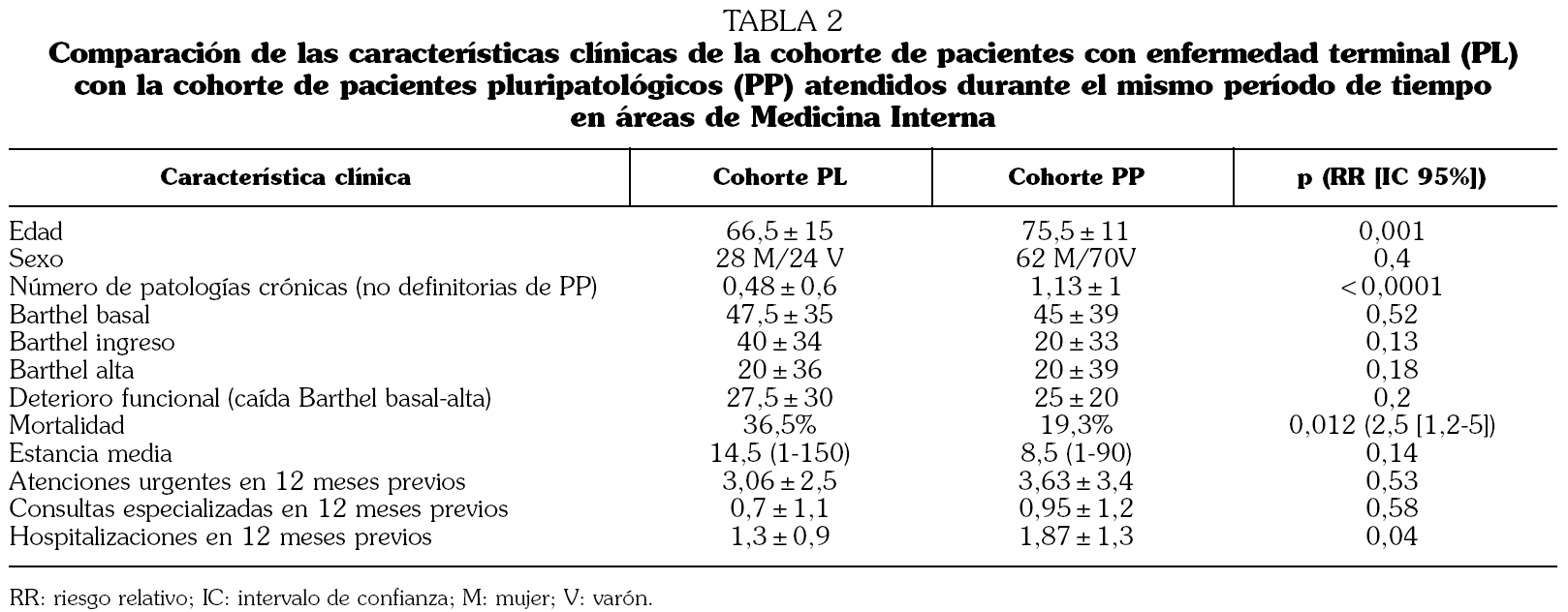Introducción. El proceso de atención a pacientes con enfermedad terminal se ha estructurado en torno a la Atención Primaria y a las Unidades de Cuidados Paliativos, quedando en un segundo plano otros especialistas. Sin embargo, se desconoce el impacto y las características clínicas y asistenciales de este grupo de pacientes en Medicina Interna. Nuestro objetivo consistió en evaluar estos parámetros en diferentes áreas de Medicina Interna de un hospital de tercer nivel. Material y métodos. Estudio prospectivo observacional de los pacientes ingresados en Medicina Interna durante junio de 2003. Se estratificó a los pacientes en tres cohortes (paliativo, pluripatológico y general). Se analizó la incidencia, procedencia, características clinicoevolutivas y consumo de recursos en los 12 meses previos al estudio. La comparación univariada de variables clínicas entre la cohorte de paliativos, pluripatológicos y general se llevó a cabo utilizando los test de Chi cuadrado, Fisher, ANOVA y post-hoc y Kruskal-Wallis. Resultados. Se incluyeron 52 pacientes (53,8% mujeres; edad media: 66,5 ± 15 años) de la cohorte global de 339. La incidencia de pacientes paliativos fue 15,4/100 ingresos. Los pacientes procedieron de Servicios Especializados (57,6%), Urgencias (27%) y Atención Primaria (10%). La estancia media fue de 14,5 (1-150) días y la supervivencia del 63,5%. El 68,5% de los fallecimientos se produjo en el domicilio. Los pacientes de la cohorte de paliativos, comparativamente con la general, tuvieron menor Barthel basal (47,5 frente a 95; p < 0,0001), al ingreso (40 frente a 75; p < 0,0001) y alta (20 frente a 75; p < 0,0001), mayor deterioro funcional durante ingreso (caída de valores basales-alta de 27,5 frente a 20 puntos; p<0,003) y no hubo diferencias en el consumo de recursos en los 12 meses previos. Con respecto a los pluripatológicos, la cohorte de paliativos tuvo menor edad media (66,5 ± 15 frente a 75 ± 11; p = 0,001) y similar limitación funcional basal al ingreso y al alta. Discusión. Los pacientes con enfermedad terminal suponen un grupo significativo en nuestras áreas de Medicina Interna, lo cual apoya el papel del internista en la asistencia a esta población y le obliga a adquirir las competencias específicas para su manejo integral.
Palabras clave:
cuidados paliativos, Medicina Interna, calidad asistencial
Introduction. The medical assistance to patients with terminal diseases has been structured with Primary Care and Palliative Care Units as protagonists, and with other specialties as secondary roles. Nevertheless the impact of this group of patients in Internal Medicine areas is unknown. Our objective was to evaluate these parameters in the area of Internal Medicine of a tertiary teaching Hospital. Material and methods. Prospective observational study of all patients attended in Internal Medicine areas during June 2003. Patients were stratified in three cohorts (palliative, pluripathologic, and general). Incidence of palliative patients, origin, clinical features, and burden of hospital care in the last 12 months were analyzed. Univariate analysis of the clinical differences between the palliative and the pluripathologic, and general cohorts was performed, using Chi-square, Fisher, ANOVA and post-hoc tests and Kruskal-Wallis test. Results. 52 (53.8% women; mean age 66.5 ± 15 years) were included from the global study cohort of 339 patients. Incidence of palliative patients was 15.4/100 admissions. The patients were admitted from other specialties (57.6%), Emergency department (27%), and Primary Care (10%). Mean hospital stay was 14.5 (1-150) days, and survival 63.5%. The 68.5% of deceases occurred at home. Patients of palliative cohort, with respect to general cohort had less functional ability at baseline (47.5 vs 95; p < 0.0001), admission (40 vs 75; p < 0.0001), and at discharge (20 vs 75; p < 0.0001), and more functional deterioration during hospital stay (mean fall in Barthel's values at baseline-discharge of 27.5 vs 20 points; p < 0.003). There were no differences in the burden of hospital care in the previous 12 months. With respect to the cohort of pluripathologic patients, palliative patients were younger (66.5 ± 15 vs 75 ± 11 years; p = 0.001) and had similar functional limitations at baseline (47.5 vs 45), admission (40 vs 20) and at discharge (20 vs 20). Discussion. Patients with terminal diseases are prevalent in the clinical setting in areas of internal medicine. These data support the role of the internist in palliative care proceedings, and prompt internists to acquire enough specific abilities to manage competitively these population.
Keywords:
palliative care, Internal Medicine, quality of care










